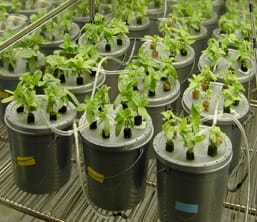Washington Post
By Barbara Damrosch
 Hydroponic gardening could not be more different from organic gardening if it tried. Maybe you’ve seen a hydroponic greenhouse operation, or a home gardener’s kit, in which plant roots are bathed in a solution of chemical fertilizers but never come into contact with any soil. It is a clever and useful system that can be used in places where the soil is contaminated, or one where a living soil does not exist, such as Mars.
Hydroponic gardening could not be more different from organic gardening if it tried. Maybe you’ve seen a hydroponic greenhouse operation, or a home gardener’s kit, in which plant roots are bathed in a solution of chemical fertilizers but never come into contact with any soil. It is a clever and useful system that can be used in places where the soil is contaminated, or one where a living soil does not exist, such as Mars.
Organic gardening, on the other hand, is a practice in which we participate in a natural system already in place, and it is complex beyond our ability to know. The living interactions of microbes, animals and plants in the soil are what created Earth’s atmosphere and keep it livable. If we don’t disrupt them, they give us healthful food with all the nutritional subtleties we’ve evolved to need.
According to James W. Brown, writing on the Web site of CropKing, a company that sells greenhouses and hydroponic equipment, the word hydroponic suffers from an image problem that the word “organic” might correct. By using a system whereby certain bacteria digest organic matter to create nutrients in a separate location, which are then “delivered to the plant via solution,” growers can “market their produce as being organic because that will command a premium price.” The process, says Brown, is “certifiable under the guidelines of the National Organic Program” (NOP).
But that’s just because the NOP is dragging its feet. Only recently have hydroponic growers become significant players and begun to avidly seek the organic label.
The NOP, as originally created, was designed to promote and protect the cultivation of food without chemical aids, in a way that helps keep Earth in ecological balance. Congress established a National Organic Standards Board (NOSB) to advise the NOP, consider new developments and invite public involvement. For the most part, over the years, the NOP has followed its recommendations.
In 2010 the board members, after weighing response from extensive public hearings, voted 12 to 1 to exclude hydroponics from organic certification. But this time they were ignored. Says board member Jay Feldman: “When you take the decisions away from the board, you erode public confidence in what organic is believed to be.”
Most countries do not let any hydroponically grown food be sold as organic. But now Mexico, Canada and Holland have entered our markets with a label that they are not allowed to use at home.
Organic is not just about safe, unsprayed food; it’s much bigger than that. A synonym for it might be “the way the natural world does business,” and the natural world is not scenery. It’s not a national park. It’s our planet. It’s the cooperative interactions of thousands of species in the soil: the worms, snails, moles, beetles, ants, protozoa, algae, bacteria and fungi — all living, dying and recycling nutrients to create an ecological balance. Without all that, we’re just a rock in space.
If you have a similar view, you can share it with the USDA by going to www.keepthesoilinorganic.org. I’m not against progress and innovation. I grow some of my food in a greenhouse, organically, with well-composted soil, and if someone else wants to grow hydroponic lettuce in theirs, that’s fine.
Just don’t call it organic.
Tip of the week
Tree and shrub branches that have been damaged by ice and snow should be removed before new spring growth for the health and look of the plant. Remove the damaged stem back to the nearest branch or leader, leaving the natural swelling or collar at the join. Lopping shears will handle smaller branches. Use a pruning saw for thicker ones, but leave branches that are large, high or near power lines to an arborist.
— Adrian Higgins

